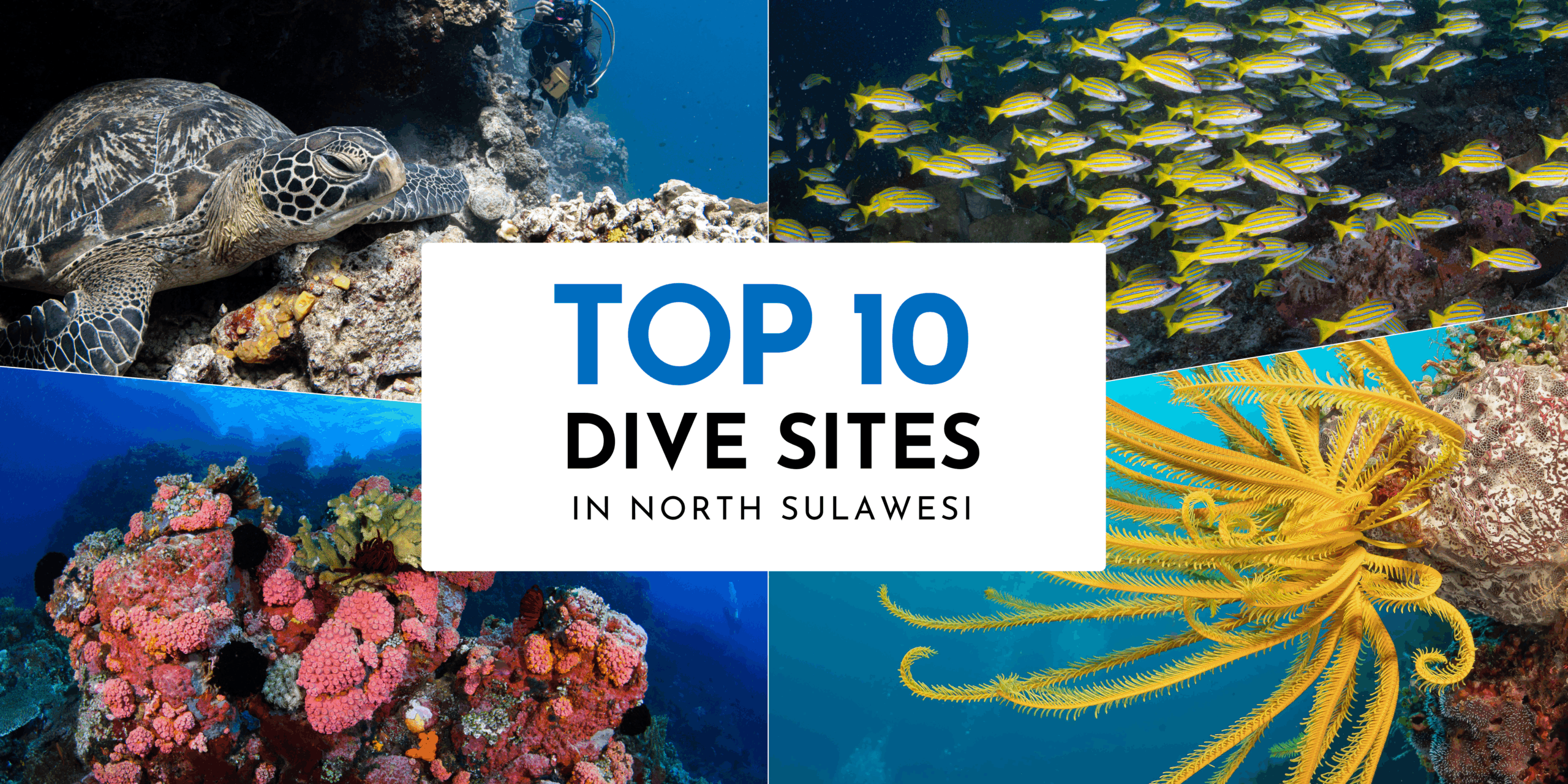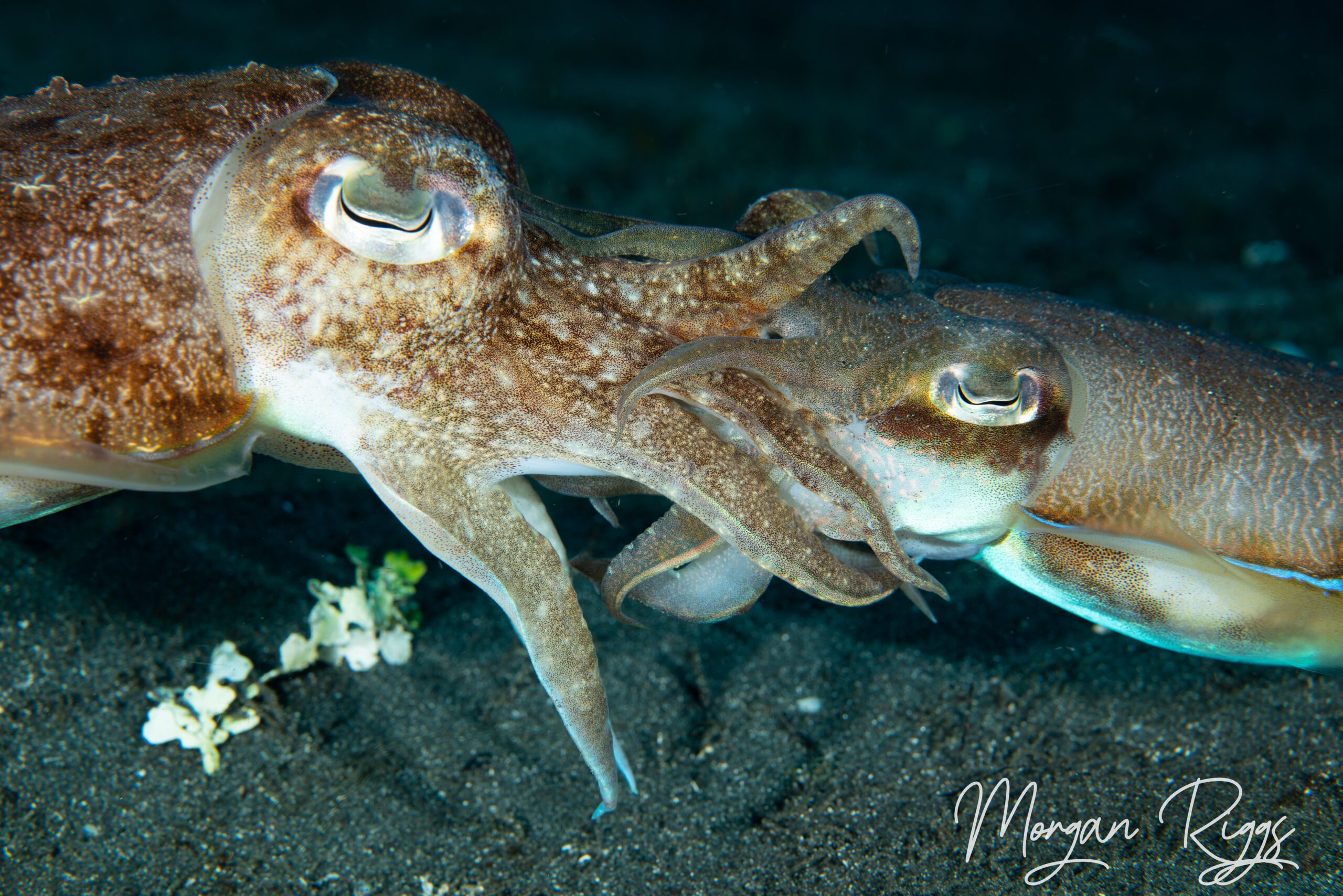
Ultimate Guide to Squid and Cuttlefish of North Sulawesi
Have you been following our series of “Ultimate Guide” Blogs? In this Ultimate Guide to Squid and Cuttlefish of North Sulawesi we take a look at the phenomenal variety of squid and cuttlefish species that we have here in North Sulawesi, reveal the best dive sites for finding them and give you a few intriguing facts about these incredible critters.
Squid and Cuttlefish in North Sulawesi
Did you know that male cuttlefish can only produce once and the females die shortly after laying their eggs, or that cuttlefish are able to shoot a cloud of black ink at predators when threatened? Read on to find out more!
1. Bobtail Squid (Euprymna berryi)
The Bobtail squid may be small but it is one of our shining stars here in North Sulawesi. Although they range in size from only 1cm to 5cm, due to their symbiotic relationship with bioluminescent bacteria which live in a light organ in their mantle they really do shine!
They live in shallow waters and swim using their fins or by jet propulsion. They also use their triangular fins to bury themselves into the sand or rubble and then they use their arms to cover themselves with sand grains as a method of disguise. Small but smart!

Humming-bird Bobtail Squid (Euprymna berryi) found during a night dive at Murex Manado
North Sulawesi’s Best Dive Sites for Bobtail Squid:
Night dives at Sabora in Bangka, City Extra in Manado, Lembeh Resort House Reef and Jahir in Lembeh.
2. Flamboyant Cuttlefish (Metasepia pfefferi)
This colorful species of cuttlefish is highly sought after by underwater photographers. What other species of critter can flash from bright purple to red, to orange, to bright white in a matter of seconds? It’s not only the colors that make this species distinct; their method of movement is also quite unique.
Flamboyants use their lower arms to walk along the sea floor while rhythmically waving the wide protective membranes on their arms when warding off predators. This species has been recorded as growing up to 12 cm but usually they range from between 5 – 8 cms. Although they are a solitary species, here in North Sulawesi at our muck diving sites we occasionally see them in pairs and even mating.
They may be colourful but don’t be deceived, the toxin that is contained in their muscles is actually the same as that of the (closely related) blue ring octopus. Like the blue ring, they only flash their colors when threatened which makes them tricky to spot as their normal base color is a dark brown. Flamboyants are active through the day when they are hunting for small fish and crustaceans in depths from 3 meters and below.
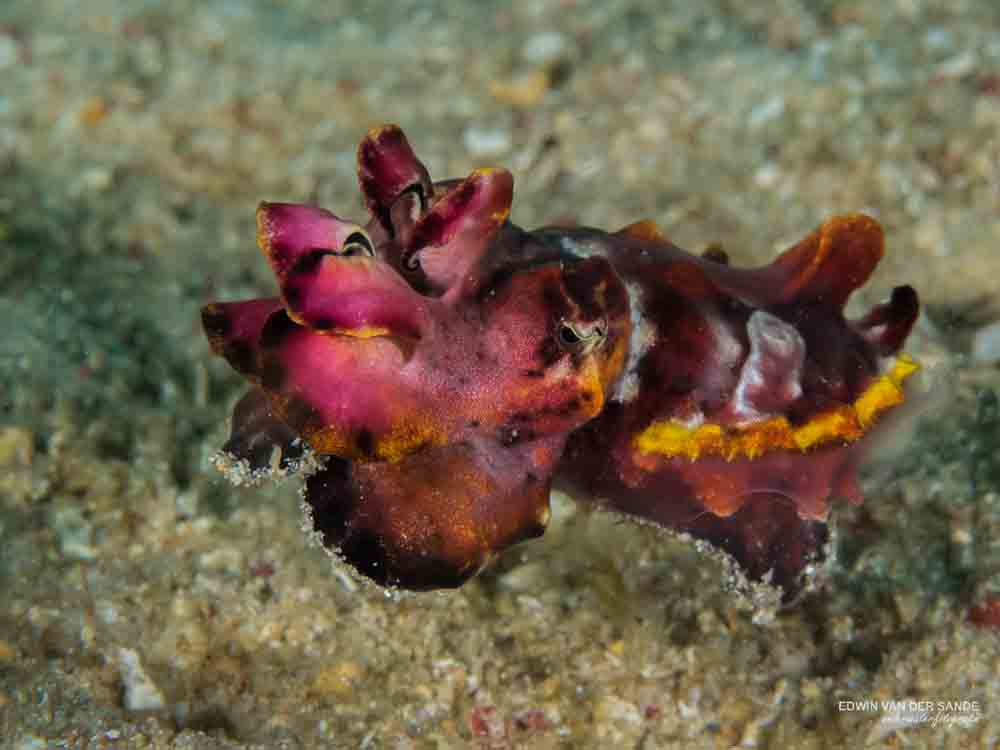
Flamboyant Cuttlefish (Metasepia pfefferi)found around Murex Bangka
North Sulawesi’s Best Dive Sites for Flamboyant Cuttlefish:
Sampiri and Peter’s Sponge in Bangka, City Extra in Manado and Air Prang and Tanjung Kubur in Lembeh.
3. Broad club cuttlefish (Sepia latimanus)
The Broad club cuttlefish is one of the most common cuttlefish species in North Sulawesi but that doesn’t mean it isn’t special. This species lives in depths that range from shallow reef tops to up to 30 meters. The Broad club can grow up to 50cms in length (that’s half a meter!!) and can weigh up to 10 kilograms!
The Broad club is an amazing species to watch as it changes colors (brown, white, green, yellow and banded) AND textures – the “skin” can change rapidly from smooth and flat to having a “spikey” appearance in seconds. The Broad club is an excellent videography subject, particularly when it is stretching out its tentacles, feeding or mating. This species preys mainly on shrimps which they appear to mesmerize with their rhythmic colored bands.
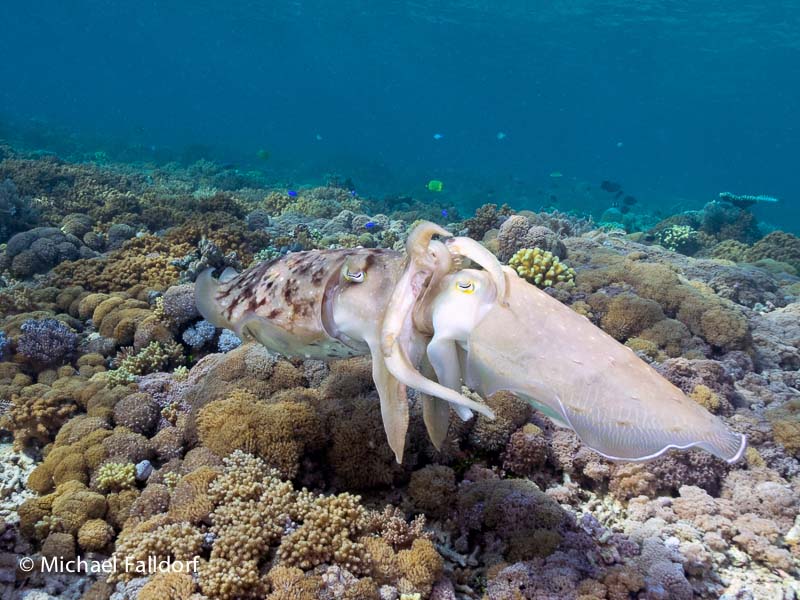
Mating Broad club cuttlefish (Sepia latimanus) at a reef around Bangka Island
North Sulawesi’s Best Dive Sites for Broadclub Cuttlefish:
Circus dive site in Manado, House Reef in Bangka and Hairball (1, 2 and 3) in Lembeh.
4. Pygmy Squid (Idiosepius paradoxus)
Pygmy squids are a species of Bobtail squid and are the smallest of all species of squid and cuttlefish – they grow up to only 1.5 cms! They frequently attach to sea grass and soft corals using a special organ which they have on their mantles.
They lay their eggs on the underside of sea grasses and this tiny species feeds on crustaceans – sometimes that are the same size as themselves! The pygmy squid can be tricky to spot due to its size but our guides know where to find them. For photographers a good macro lense is recommended!
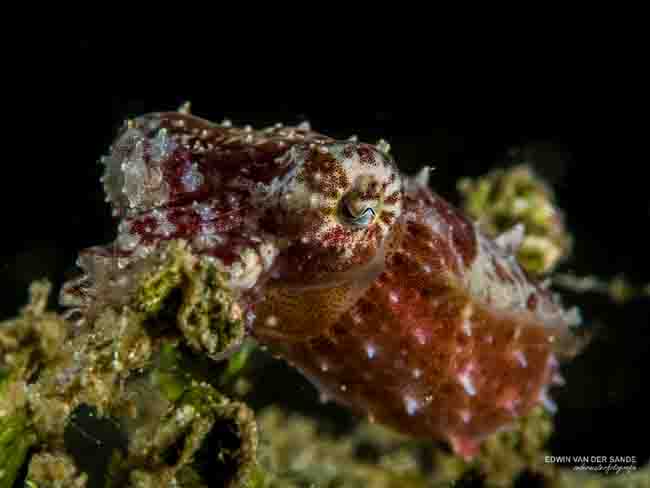
Pygmy Squid (Idiosepius paradoxus) at Bethlehem
North Sulawesi’s Best Dive Sites for Pygmy Cuttlefish:
Bethlehem and City Extra in Manado, Pantai Kecil in Bangka and Jahir in Lembeh.
5. Golden Cuttlefish – Sepia esculenta
This is one of our favorites – it’s not tiny but it’s not big either. It grows to around 18cms in length and is usually found on sandy reef patchy where it partially burrows into the sand. The striking feature of this species is the bright blue line that flashes around the outer edges of its mantle when threatened.
Although named the “golden” cuttlefish its coloration changes from gold to dark brown, to white and yellow. Textural changes also appear and the “skin” can go from smooth to spiked in seconds (similar to the Broad club). This species preys on small fish and crustaceans which they catch by changing their skin color to match that of their surroundings – perfect camouflage for hunting!
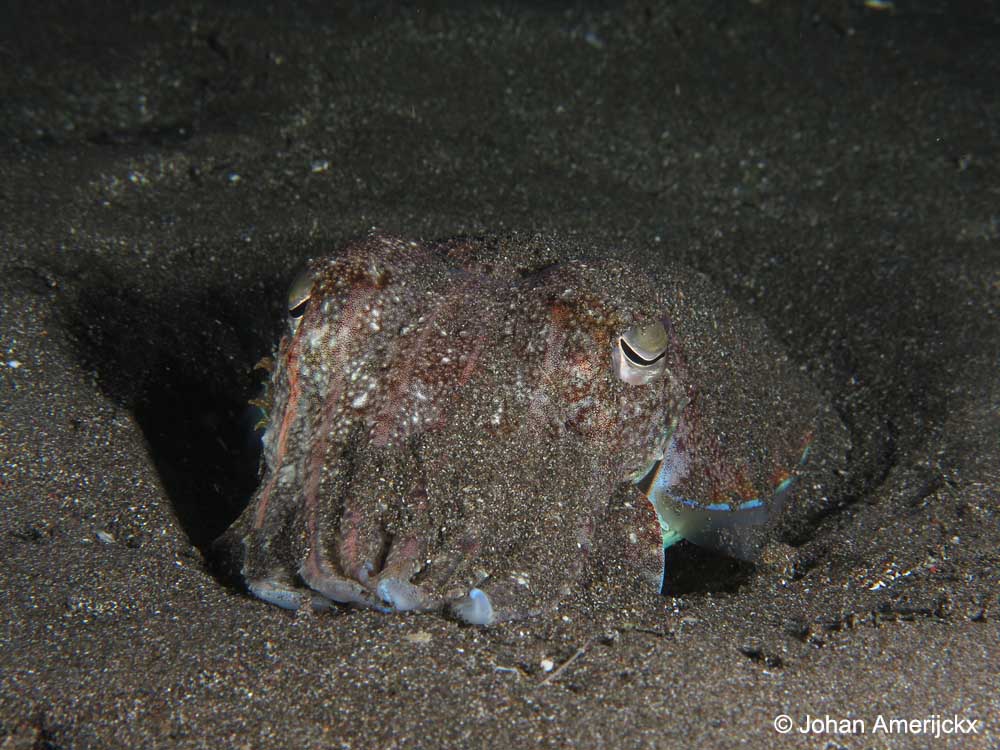
Golden Cuttlefish – Sepia esculenta found during a night dive at City Extra
North Sulawesi’s Best Dive Sites for Golden Cuttlefish:
This species is very site specific and we have our best sightings at Bethlehem and City Extra in Manado.
6. Bigfin Reef Squid – Sepioteuthis lessoniana
Big fins, big fun! This species of squid is relatively common here in North Sulawesi and can often be found on shallow reef tops where they hover in the water column. We regularly spot them at our dive sites that have sand and sea grass areas and close to boat mooring lines on which they lays eggs. Divers sometimes mistake this species of squid for cuttlefish because of the way they move and because, just like cuttlefish, they have a large oval fin that extends throughout the margins of the mantle.
They are small to medium-sized squids, averaging 3.8 to 33 centimetres in length and they have the fastest recorded growth rate of any large marine invertebrate, reaching 600 g (1.3 lb) in only four months. Sadly, they are a short-lived species, with a maximum recorded lifespan of 315 days. This curious species is often attracted to dive torches during night dives which gives you the perfect photo opportunity.
North Sulawesi’s Best Dive Sites for Bigfin Reef Squid:
The best dive sites in North Sulawesi for spotting Bigfin Reef squids are the House Reef in Bangka, Malalayang in Manado and Nudi Falls and Nudi Retreat in Lembeh.
Ready to get up close and personal with these amazing creatures? Our experienced guides at Murex Resorts are eager to show you the ropes. Contact us at reservations@murexresorts.com.
Explore three diving paradises in one trip: Discover the ultimate paradise – Bunaken, Bangka and Lembeh – in a single vacation. Find out more about our Passport to Paradise package.
Check out Murex Resort rates and reserve your spot now. Prepare for an incredible diving journey through the marine treasures of North Sulawesi.


